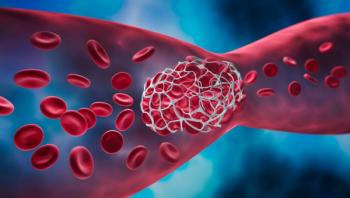
Fitusiran Emerges as a Potential Pan-Hemophilia Rebalancing Agent
Promising results were reported in The Lancet and The Lancet Haematology.
Could there be a one-size-fits-all agent in the works for both hemophilia A and hemophilia B?
Interest is growing in fitusiran (3’-adenosine phosphate triglycan – end group), an experimental hemostasis rebalancing agent that has shown potential to work against inhibitors to clotting factor therapy, simplify administration with fewer doses, and provide continuous bleeding protection without peaks and troughs.
“Fitusiran reduces antithrombin and allows the body to handle bleeds with existing levels of thrombin, thereby achieving hemostasis. It can work in both hemophilia A and hemophilia B, with or without inhibitors,” said Alok Srivastava, M.D., of Christian Medical College Vellore in India, the lead author of
These findings in patients with hemophilia A and B without inhibitors were published in tandem with findings from a study of fitusiran in patients with inhibitors to clotting-factor therapy.
Sanofi is developing fitusiran, a small interference RNA therapeutic, and funded both trials
“We have for once a therapy that works across all subsets of hemophilia. Through subcutaneous injection, it can maintain steady state levels that enhance hemostasis that does not depend on peaks and troughs of factor levels, as we had conventionally with the clotting-factor concentrates,” Srivastava said.
Traditional hemophilia treatment has involved frequent intravenous injections of factor VIII and IX concentrates. The injections are only partly successful, and development of inhibitors to these agents can vastly complicate treatment. Antithrombin inhibitors such as fitusiran are among alternative “rebalancing” agents under development. It is believed that fitusiran may also prove of value in other severe bleeding disorders, although use of this experimental agent carries the risk of vascular thrombosis due to coagulation imbalance.
In recent trials, drug developer Sanofi appears to have mitigated this risk by preserving minimum levels of the clotting inhibitor antithrombin.
In ATLAS A/B, 51% of patients (40/79) who received fitusiran 80 mg as monthly prophylaxis experienced no bleeds compared with 5% (2/40) in the comparison group who received clotting factor concentrates as needed, rather than as prophylaxis.
In a second phase 3
In both ATLAS-A/B and ATLAS-INH, investigators enrolled patients who used clotting factor replacement and bypassing agents on demand because of the difficulty in enrolling patients who are stabilized on prophylaxis care and unwilling to switch.
In both trials, treatment with fitusiran significantly outperformed on-demand care.
The reduction in bleeds in ATLAS-INH was described as both important and statistically significant by study lead author
“Although some patients had elevations in (alanine) transaminase, which is associated with liver inflammation, these were mostly transient and mild, and none of the patients discontinued fitusiran because of that. That was about 25% of the patients,” he said.
One out of 40 patients was discontinued due to a thrombotic safety issue. “Considering how effective the drug was at reducing bleeding in this very difficult-to-treat population — again, these are patients with inhibitors—the safety issues are relatively infrequent to the point that we strongly believe the benefits of a drug like fitusiran for patients with hemophilia A and B with inhibitors far outweighs these risks,” Young said.
In ongoing studies, Sanofi is investigating fitusiran in lower and less frequent doses, as few as 6 subcutaneous injections per year, with a maintained antithrombin level of 15% to 35%.
Newsletter
Get the latest industry news, event updates, and more from Managed healthcare Executive.


















































